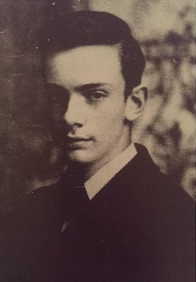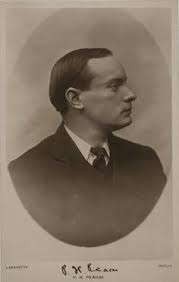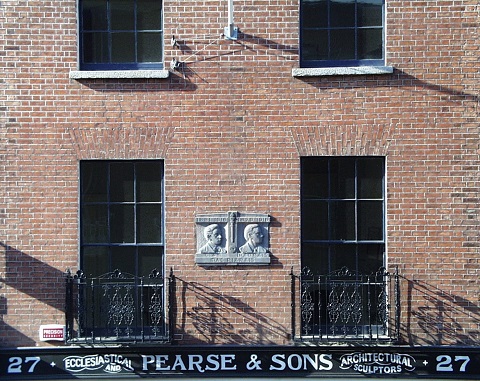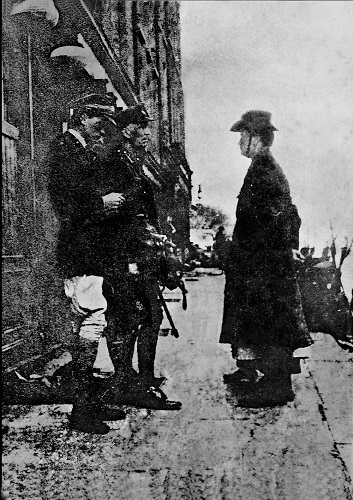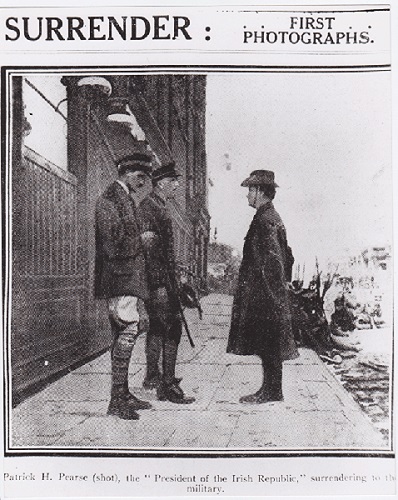| Life | |||||||
| 1879: [Patrick Henry; Padraig Mac Piarais; also Pádraic; pseud. “Colm Ó Conaire”]; b. 27 Gt. Brunswick St., Dublin [now Pearse St.]; son of James Pearse, an English mason and monumental sculptor from Birmingham, orig. a Unitarian (converting to Catholicism on his second marriage), who came to Ireland to work on the Pugin Church on Thomas St. and also sculpted the ‘Erin Go Bragh’ pediment of the National Bank, College Green; his mother Margaret, Pearse’s second wife, was a native of Co. Meath; br. Willie and two sisters; ed. Westland Row CBS, begins to learn Irish, 1893; | |||||||
| 1896: joins Central Branch of Gaelic League, Oct. 1896; works as student-teacher at Westland Row Christian Brothers School, 1896; Royal University Matriculation examination, June 1898; embarked on two-year study for BA, spending the third year at UCD; studied for King’s Inns at TCD; Executive Committee of the Gaelic League, Summer 1898; first visits Aran Islands, 1898; issues Three Lectures on Gaelic Topics (1898); teaches weekly Irish class at Newman House under auspices of UCD, 1899, and observed by James Joyce in the classroom (‘Mr Hughes’ in A Portrait); teaches at Alexandra College, and Westland Row (CBS ); examiner in Irish history at Clongowes College, 1899; | |||||||
| 1900: death of his father occurs, Sept. 1900; stone-carving business renamed Pearse & Sons (dissolved 1910); Royal University of Ireland, and King’s Inns; Bar, 1901, did not practise; final exams at the Royal University and at King’s Inns, June 1901; 2nd class BA in Irish, English, French (modern languages), and BL, 1901; called to Irish bar; ed. with Tadhg Ó Donnchadha, An tAithriseóir [The Reciter] (2 vols. 1900-02); ed. An Claidheamh Soluis, March 1903-late 1909, publishing his educational views in it; acted for the Gaelic League in his only case as a barrister, 1905; published Poll an Piobaire [The Piper’s Cave] (1905); travels to Belgium to examine system of bilingual education, June 1905 (writing extensively on same in An Claidheamh Soluis); published prose poems as ‘Colm Ó Conaire’, 1906; published Iosagan agus Sgealta Eile [Little Jesus and other Stories] (1907); was among those who objected to The Playboy of the Western World (1907) - later becoming convinced of his ‘true love of Ireland’ (“From a Hermitage”, 1913); contrib. The United Irishman; lect. in Irish, UCD; | |||||||
| 1908: fnd. Sgoil Éanna [Scoil Eanna; St. Enda’s] in Cullenswood House, on Oakley Rd., Ranelagh, Sept. 1908 [finally closed in 1935], his staff including Willie Pearse, Thomas Macdonagh, Joseph Mary Plunkett, and Con Colbert; first advertised in The Leader as ‘Sgoil Ghaedhealach le h-aghaigh Gaedheal Óg/An Irish-Ireland School for Catholic Boys’, reflecting his admiration for the educational ideas pioneered by Mria Montessori; sons of Eoin MacNeill, William Bulfin and Stephen Gwynn among first to attend; teachers incl. William Pearse, Joseph Plunkett, Thomas MacDonagh and Con Colbert; syllabus incl. visiting lectures on french literature, phenetics, philosopyy, medieval history, Egyptology, botany and archaeoology; issues Iosagán agus Scéalta Eile (1907) and ed., Bruidhean Chaortainn: Scéal Fionnaidhneachtna (1908); writes ‘Irish-Ireland in atmosphere’, Sept. 1908; | |||||||
|
|||||||
| 1909: ed. Macaoimh at St. Enda’s, 1909-13, which included some of his own scripts; produced “The Boy Deeds of Cuchulainn” [Gl. Macghníomhartha Chú Culann - var. Cuchulainn’s Boyhood Deeds], an open-air pageant based on the Táin Bó Cuailgne, and incorporating hurling scenes, with schoolboy actors, before an audience of 500 at Cullenswood Hse., Ranelagh; the family firm of ecclesiastical sculptors - in which his brother Willie was active - closes, 1910; Pearse moves his school to The Hermitage, Rathfarnham, formerly the home of Emmet’s sweetheart Sarah Curran, 1910; | |||||||
| 1911: his Passion Play, An Pháis, produced at the Abbey in the week before Easter 1911; estab. St. Ita’s for girls at Cullenswood House; incurs liabilities through over-ambitious expansion of the schools; writes the poem “A Mhic Bhig na gCleas [Little Lad of the Tricks]”, Dec. 1910; writes Iosagán as play (1910); issues play, An Rí (1911); ed. An Barr Buadh, 1912; issues The Murder Machine (1912) - in which he wrote of the Irish as a nation of eunuchs and slaves while representing the Gaelic Revival as a way of re-instilling virility in Irish youth; addressed Home Rule meeting in O’Connell Street, and looked forward to forming an opposition party, 1912, but later becomes convinced that England would not ‘keep faith’ in the face of Unionist and Orange opposition; his play An Rí produced, 1912; builds cottage at Rosmuc in Connemara; produces second pageant as “The Defence of the Ford”, from the Ulster Cycle, with 200 performers, at Croke Park as part of St. Enda’s Fête at Croke Park [then Jones’s Rd.], Dublin; attends first meeting of Irish Volunteers, November 11, 1913; swears secret oath of Irish Republican Brotherhood [IBR], December 1913, and soon after joins Supreme Council and Provisional Committee of the Irish Volunteers; issues Direct Method Course in Irish (1913); | |||||||
| 1914: leaves Ireland for America via Cobh on fund-raising trip for St Enda’s, February-May, 1914; lectured in New York on ‘Robert Emmet and the Ireland of Today’ (2 & 9 March 1914); contrib. to Irish Freedom, ed. Bulmer Hobson; published there ‘From a Hermitage’ (June 1913-Feb. 1914); receives arms from Childer’s boat the Asgard, Summer 1914; responded to the Bachelor’s Walk Massacre of 26 July 1914 by asserting that ‘[t]he whole [Volunteer] movement, the whole country, has been re-baptised by bloodshed for Ireland’); appt. Director of Military Organization for Volunteers, Dec. 1914; issues An Sgoill: And How Does She Stand? (1914) and Suantraidhe agus Goltraidhe [Songs of Sleep and Sorrow] (1914); ed., Specimens from an Irish Anthology (1914); greeted outbreak of World War I with the remark, ‘the old heart of the earth needed to the warmed with the red wine of the battlefields’ - to be answered by James Connolly, ‘[socialists] socialists ‘do not think the old heart of the earth needs to be warmed with the red wine of millions of lives. We think anyone who does is a blithering idiot’; | |||||||
| 1915: appt. Commandant (unattached to any battalion), March 10, 1915; organises drilling; gives oration at O’Donovan Rossa’s grave, Glasnevin Cemetery, 1 Aug, 1915, declaring that this generation had renewed its baptismal vows in the Fenian faith’ (‘While Ireland holds these graves, Ireland unfree shall never be at peace’); drew up political constitution of Gaelic League at 1915 Ard Fheis, at which the IRB achieved dominance by strategy of issuing proxy votes to non-Irish speaking IRB-men (e.g., 50 in Dundalk); issues The Singer (1915), in which McDara resists ‘the Gaul’; issues Songs of the Irish Rebels (1915); Eoin (1915), play, and Ghosts (1915); joined eleven-man IRB Supreme (Military) Council, Sept. 1915; plans 1916 Rising; professes that ‘the old heart of the earth needed to be warmed with the red wine of the battlefields’, Dec. 1915; last public speech, Christmas Day, 1915, alludes to ‘the power of the ghosts of the nation’; urged his publisher to rush publication of his collected works, telling him he would ‘shortly know the reason’; issued The Master (1915); | |||||||
| 1916: issues pamphlets “The Separatist Idea”, “The Spiritual Nation”, and “The Sovereign People” [‘the right of property is not good against the common welfare of the people’]; gives ‘General Orders’ for manoeuvres, 3 April, 1916; signs the Proclamation first, along with six other IRB members; appt. commander-in-chief of Provisional Republic forces at GPO, Monday, 25 April 1916 (Easter); assembles Volunteers and Citizen Army (under Connolly) at General Post Office; as Commandant General and Commander-in-Chief of the Army of the Irish Republic and President [var. Chairman] of the Provisional Government of the Irish Republic; reads the Proclamation on the steps of GPO; surrendered to Brig.-Gen. William Lowe on Parnell St., 3.30 p.m., 29 (Friday) April; held prisoner at Arbour Hill Barracks and later at Richmond Barracks, where he is tried for Treason by court-martial declaring: ‘We seem to have lost [..., &c.; as infra]; | |||||||
| condemned to death by court martial, Gen. Blackadder presiding; wrote last letter to his mother, asking her to accept his death as ‘a sacrifice which God asked of me and you’ [Letters]; executed by firing squad in Kilmainham Gaol, 3.30 a.m., 3 May 1916, together with his brother Willie; buried in quick lime in Arbour Hill; An Mháthair agus Sgéalta Eile [The Mother ...] (1916) was issued posthumously; his Collected Works was edited by Desmond Ryan, 1917-22; P. S. O’Hegarty prepared a bibliography in 1931; Pearse was played by Eoin Ó Súilleabháin in the 1966 RTE 50th Anniversary production Easter Week 1916, scripted by Hugh Leonard in 8 parts; a ten-shilling [deic[h] scilling] coin with Pearse’s head on one side and Oliver Sheppard’s “Cuchulain” on the other was introduced in 1966, but did not flourish - 1.25 million of an issue of 2 million being melted down afterwards; | |||||||
| accused by Fr. Francis Shaw, SJ, of pre-empting the ideal of messianic sacrifice embodied by Christ for political purposes, 1972; later accused of death-wish [Liebestod] and latent homosexuality by Ruth Dudley Edwards in her biography, The Triumph of Failure (1977); a film, Revival: Pearse’s Concept of Ireland (1979), was commissioned by the Dept. of Taoiseach under Jack Lynch and directed by Louis Marcus; the Pearse Museum was established at St. Enda’s Rathfarnham, renovated and redesigned for purpose, c.2012; his Collected Plays, edited by Róisín Ní Ghairbhí and Eugene McNulty, were launched at Smock Alley Theatre Banquet Hall, with Declan Kiberd as guest speaker, on 24 April 2013. IF DIB DIW DIH DIL KUN FDA OCIL | |||||||
[ top ]
|
[ top ]
Works| Contemporary Writings |
|
Note: Mary Brigid Pearse, The Home Life of Patrick Pearse (Dublin 1934), contains an autobiographical fragment (pp.13-40). |
| Collected & posthumous editions |
|
| Correspondence |
|
| [ top ] |
| Reprints |
|
|
| Patrick Pearse’s Oration at the
Grave-side of O’Donovan Rossa (1 Aug. 1915) |
Bibliographical details
Collected Works: A note on the publishing history of Pearse’s works is supplied by Fr. Francis Shaw as a footnote to his ‘the Canon of Irish History: A Challenge’, in Studies, Vol. 61 (1972), pp.1133-52; rep. The Field Day Anthology of Irish Writing, 1992, Vol. 3). In it, Shaw lists The Collected Works of Padraic [sic] H. Pearse, 5 vols. - [being] I: St Enda’s and its Founder; II: Political Writings and Speeches; III: Songs of the Irish Rebels, &c.; IV: Plays, Stories, Poems, and V: Schríbhinní Phádraig Mhic Phiarais [as Gaeilge]), issued by The Phoenix Publishing Co., Dublin, Cork, Belfast; with numerous edns. from 1917, being re-impressions with the same pagination. The earlier edns. bear the imprint Maunsell [sic] & Roberts, Dublin & London, with the slightly different title of The Complete Works of P. H. Pearse on the spine, while later still edns. bear imprint of Talbot Press. [FDA3 592.] Cf., FDA3 601n., bibl., The Collected Works of Padraic [sic] H Pearse, Political Writings and Speeches (Dublin: Phoenix Publishing Co., 1929).
The Surrender of Patrick Pearse to Brig.-Gen. William Lowe at Parnell St., Dublin - 29th April 1916
The original photo (modern restoration) Version in Daily Sketch (10th May 1916)
The Surrender of Patrick Pearse to Brig.-Gen. William Lowe at Parnell St., Dublin - 29th April 1916
The surrender: Notes:
[ top ]
Criticism| Major studies | |
|
|
| ... et al. | |
|
|
See also Bryan Fanning & Tom Garvin, ‘Desmond Ryan (ed.), Collected Works of Padraic H. Pearse: Political Writings and Speeches (1917)’, in Books That Define Ireland (Sallins: Merrion 2014), Chap. 11 |
|
See also W. P. Ryan, The Pope’s Green Island (London: James Nisbet 1912), chap.: “The Hero of the College” [on Pearse]; P. S. O’Hegarty, The Victory of Sinn Féin (1924) & P. S. O’Hegarty, “Bibliography of Patrick Pearse”, in Dublin Magazine, Vol. 6, No. 3; Martin Williams, ‘Ancient Mythology and Revolutionary Ideology in Ireland, 1878-1916’, in Historical Journal, vol. XXVI, No. 2 (1983), pp.307-28; William Irwin Thompson, The Imagination of An Insurrection, Dublin, Easter 1916: A Study of an Ideological Movement (OUP 1967; Harper & Row 1972); G. F. Dalton, ‘The Tradition of Blood Sacrifice to the Goddess Eire’, in Studies, vol. LXVII, pp.343-54; Frank Sewell, ‘Between Two Languages: Poetry in Irish, English and Irish English’, in Matthew Campbell, ed., The Cambridge Companion to Contemporary Irish Poetry (Cambridge UP 2003), pp.149-68, espec. p,150ff.; Joseph Valente, The Myth of Manliness in Irish National Culture, 1880-1922 (Illinois UP 2011), x, 289pp. [Parnell, Yeats, Pearse, et al.]; Róisín Ní Ghairbhí, Willie Pearse [16 Lives ser.] (Dublin: O’Brien Press 2015) [biog. extract as infra]. |
Note: There is a 1971 article on Pearse by David Thornley in Studies (1971) - reflecting on Thornley’s characterisation of Pearse as ‘a rather likeable young man .. with a sense of destiny totally at odds with his sense of fun’ [Cited in The Irish Times, 20 July 2013]. Thornley also wrote on Pearse in F. X. Martin’s commemorative collection in the Thomas Davis lecture series’ - presum. Leaders and Men of the Easter Rising: Dublin 1916 (London: Methuen, 1967).
[ top ]
References
Stephen Brown, Ireland in Fiction (Dublin: Maunsel 1919), lists The Mother, done into English by Rev. T. A. Fitzgerald OFM, with foreword by Helena Concannon, MA, with photos of author and his mother (Dundalgan 1916); Collected Works, Vol. 1, Poems, Plays, and Stories, intro. Rev. P. Browne, Maynooth, trans. Joseph Campbell (Maunsel 1917).
Dictionary of National Biography has no entry on Pearse prior to Missing Persons (1992) - where a new entry is provided by Ruth Dudley Edwards.
Robert Hogan, ed., Dictionary of Irish Literature (Dublin: Gill & Macmillan 1979), article cites eight dramatic works, 1909-1916, six for Scoil Eanna, incl. a pageant of Táin Bó Cuailgne, a passion play, and four one-acts; Iosagán and Other Stories (1907),; in Irish The Singer, play advocating blood-sacrifice (1915); The Mother and Other Stories (1916); 12 Gaelic lyrics in Suantraidhe agus Goltraidhe [Songs of Sleep and Sorrow] (1914). ‘In four stories of the second collection [The Mother &c.], Pearse moved from the child’s world, which had dominated Iosagán, to that of the adult, exhibiting improved technique, increased control of structure and form, and a deeper awareness of life’s struggles.’ Further: his Irish stories help to establish a prose style based in spoken rather than archaic, literary Gaelic.
| Róisín Ní Ghairbhí, Willie Pearse [16 Lives ser.] (Dublin: O’Brien Press 2015) |
|
| —Available in part online; accessed 10.08.2015. |
Note - in an Irish Times review, Diarmaid Ferriter remarks that the book suffers from a lack of sources other than the ‘stained-glass’; biographies of Patrick Pearse written after the Rising by men like Desmond Ryan. He writes of Pearse, Snr.: ‘Ní Ghairbhí’s book does contain a very interesting potted history of Willie’s father, James, an intriguing character. James overcame childhood poverty to become a highly regarded sculptor; he was an avid reader and admirer of the radical secularist and republican Charles Bradlaugh and became an atheist, but Patrick and Willie, in contrast, embraced their mother’s devout Catholicism. It is a pity there is not more elaboration on why this was so and on what lay at the heart of Willie’s reticence and his “preoccupation with sin”.’ (Irish Times, 9 May 2015 - available online; accessed 17.08.2015.) |
Dictionary of Irish Architects has it that he was born into poverty in London in 1839 and brought to Dublin from Birmingham by Charles William Harrison, circa 1860, to be foreman of his monumental sculpture workshop at 178 Great Brunswick Street [...] formed a partnership with Patrick J. O’Neill in the early 1870s [...] Pearse Snr. died in 1900. (See online.) Notes cite Theo Snoddy’s account of William Pearse in Dictionary of Irish Artists: 20th Century (1996), p.389, and from an article on Sharp in Irish Builder, 46 (18 June 1904), p.372. Two photographs of him appear in Pat Cooke, Sceal Scoil Eanna: the Story of an Educational Adventure (Office of Public Works, 1986), 5 & 6. |
Seamus Deane, gen. ed., The Field Day Anthology of Irish Writing (Derry: Field Day 1991), Vol. 2, selects The Murder Machine; O’Donovan Rossa, Graveside Panegyric; The Sovereign People [288-95]; The Coming Revolution; ‘I Am Ireland’, ‘The Rebel’ [556-59]; Collected Works, ‘The Fool’, ‘The Mother’, ‘The Christmas’, ‘The Wayfarer’, ‘To My Brother’, ‘Why Do Ye Torture Me?’, ‘Long To Me Thy Coming’, ‘A Rann I Made’, ‘Christ’s Coming’ [758-79]; and references. NOTE, he quotes St. Colmcille, “if I die it shall be from the excess of the love I bear the Gael.” [292]. BIOG, 561 [as supra], FDA3 selects from An Mháthar agaus Sgéalta Eile/The Mother and Other Stories, ‘An Deargadaol’/ ‘the Deeargadaol’, ‘Suantraidhe agus Goltraidhe’; REFS & REMS, 160n. 457. 480, 502, 503, 506-9; 538. 547. 565-66, 568, 572. 580. 583, 590-5, 600-01, 682, 683, 734, 746, 747, 810, 815, 816; 1024, 1266n, 1309, 1310. BIOG & WORKS, 932 [as supra]. Note, bio-bibliographical entries distributed between FDA2 and FDA3, with some difference, e.g., FDA2, ‘died at the hands of an English firing squad’, allowing for emphasis on the effect of his editorship on modern Irish.
Fr. Francis Shaw, ‘the Canon of Irish History: A Challenge’, in Studies, Vol. 61 (1972), pp.1133-52 [rep. in The Field Day Anthology of Irish Writing, 1991], contains a bibl. note: The Collected Works of Padraic [sic] H. Pearse, 5 vols. [being] I: St Enda’s and its Founder; II: Political Writings and Speeches; III: Songs of the Irish Rebels, &c.; IV: Plays, Stories, Poems, and V: Schríbhinní Phádraig Mhic Phiarais, all issued by The Phoenix Publishing Co., Dublin, Cork, Belfast. Further, numerous edns. from 1917 are re-impressions with the same pagination; the earlier edns. bear the imprint ‘Maunsell [sic for Maunsel] & Roberts, Dublin & London, with the title The Complete Works of P. H. Pearse on the spine. Later eds. have imprint of Talbot Press. [FDA3 592]. Vide The Field Day Anthology of Irish Writing, Vol. 3 601n., bibl., The Collected Works of Padraic [sic] H. Pearse: Political Writings and Speeches (Dublin: Phoenix Publishing Co., 1929).
Joseph Lee, Ireland 1912-1985, Politics and Society (1989), p.37n., bibliographical citations: Séamus Ó Buachalla, ed., The Letters of P. H. Pearse (Colin Smythe 1980) [complete]; Ó Buachalla has assembled Pearse’s educational writings, scattered and often anonymous, as A Significant Irish Educationalist (Dublin & Cork 1980), and summarised the result in Ó Buachalla, ‘An Piarsach mar Oideachasoir’, Feasta, 2, 5 (1976); R. D. Edwards, Pearse, The Triumph of Failure [1977], remains the only historically satisfying biography.
Hyland Books (Cat. 214) lists Pearse, The Spiritual Nation [Tracts for the Times No.12] ([Feb.] 1916), 18pp.; Desmond Ryan, trans. Louis le Roux, Patrick H Pearse (1932).
[ top ]
British Library holds [1] Poems of the Irish Revolutionary Brotherhood. Thomas MacDonagh, P. H. Pearse ... Joseph Mary Plunkett, Sir Roger Casement. Edited by P. Colum and E. J. O’Brien. New and enlarged edition. xxxv, 71pp. Small, Maynard & Co.: Boston, 1916. 8o.; [2] [Based on MSS. 23. M. 19. and 23. A. 49. in the Library of the Royal Irish Academy.]. iii, 72pp. 1906. 8o.; [3] viii. 61pp. 1912. 8o.; [4] 117pp.. 1918. 8o.; [5] The Stories of Padraic Pearse dramatised by M. H. Gaffney, etc. [Including three plays written by Pearse.]. 228pp. Talbot Press: Dublin, Cork,; [1935.] 8o.; [6] [L’Irlande militante.] Patrick H. Pearse. Adapted from the French of L. N. Le Roux and revised by the author. Translated ... by Desmond Ryan.; [With a portrait.]. xiii. 440pp. Talbot Press: Dublin, 1932. 8o.; [7] L’Irlande militante. La vie de Patrice Pearse. Avec une introduction historique et 15 photographies [including portraits]. 335pp. Rennes, 1932. 8o.; [8] 1900; [9] (Patrick H. Pearse: storyteller.) Irish and English. 81pp. Talbot Press: [Dublin, 1920.] 8o.; [10] [With plates, including portraits.]. x, 262pp. 1938. 8o. 11] Collected Works of Pádraic H. Pearse. Phoenix Publishing Co.: Dublin, [1917?] 8o.; [12] Collected Works of Padraic H. Pearse. [With an introduction by P. Browne. Translations from the Irish by Joseph Campbell.]. Maunsel & Co.: Dublin & London, 1917-1922. 3 vol. 8o.; [13] From a hermitage. Dublin: “Irish Freedom” Office, 1915. 27pp. 22 cm.; [14] Ghosts. 20pp. Whelan & Son: Dublin, 1916. 8o.; [15] How does she stand? Three addresses. Dublin: “Irish Freedom” Office, 1914. 16pp. 22 cm.; [16] How does She stand? Three addresses ... Second edition. (Reprinted from verbatim reports in the Gaelic American.). 16pp. “Irish Freedom” Office: Dublin, 1915. 8o.; [17] In First Century Ireland. 43pp. Talbot Press: Dublin & Cork, [1935.] 8o.; [18] Iosagan and other stories. Translated by Joseph Campbell. Dublin: Maunsel & Co., 1918. pp.229-308. 20 cm.; [19] Ó pheann an Phiarsaigh i téacsanna a togadh as an saothar liteartha a rinne Pádraig Mac Piarais. (Eagrán caighdeánach scoile.-Eagarthóir, M. Ó. Siochfhradha.). Áth Cliath: Comhlacht Oideachais na hÉireann, [1966]. 111pp.; illus., port. 19 cm.; [20] Poems. Dublin & London: Maunsel & Co., 1918. pp.311-41. 19 cm. [21] The murder machine. Dublin: Whelan & Son, 1916. 20pp. 22 cm.; [22] The Separatist Idea. [Another copy.]. 20pp. Whelan & Son: Dublin, 1916. 8o.; [23] [The Singer.] 49pp. 1937. 8o.; [24] The Singer, and other plays. (Reprint.) [The editor’s postscript signed: D. R.]. 123pp. viii. Talbot Press: Dublin, 1960. 8o.; [25] The singer and other plays. By Padraic Pearse. [With a “Chronological note” signed: D. R., i.e. Desmond Ryan.]. Dublin & London: Maunsel & Co., 1918. 123pp. iv. 19 cm.; [26] The Sovereign People. 20pp. Whelan & Son: Dublin, 1916. 8o.; [27] The Spiritual Nation. 18pp. Whelan & Son: Dublin, 1916. 8o.; [28] The Story of a success ... Being a record of St. Enda’s College, September, 1908, to Easter, 1916. Edited by Desmond Ryan. xiii, 127pp. Maunsel & Co.: Dublin & London, 1917. 8o.; [29] Three lectures on Gaelic topics. Dublin: M. H. Gill & Son, 1922. 55pp. 19 cm.; [30] Three Lectures on Gaelic topics. 59pp. M. H. Gill & Son: Dublin, 1898. 12o.; [31] 80pp. [1936.] 8o.; [32] 95pp. Wm. Tempest, The Dundalgan Press: 1916. 8o.; [33] 112pp. [1937.] 4o.; [34] 268pp. 1919. 8o.; [35] [In verse.]. 19pp. “The Irish Review”: 1914. 8o.; [36] The mother, and other tales . Done into English by Rev. T. A. Fitzgerald, etc. [Another copy]. Dundalk: Dundalgan Press, 1916. xiv, 88pp. plates; ports. 19 cm.; [37] A direct method course in Irish. Pt. I. (The St. Enda books for Irish Schools.). iv, 52pp. Maunsel & Co.: Dublin & London (1913.) 8o.; [38] The Man called Pearse. 130pp. Maunsel & Co.: Dublin & London, 1919. 8o.; [39] Patrick Pearse-Irish patriot. [Dublin?], 1937. 10pp. 22 cm.; [40] Tribute to Thomas Davis ... With an account of the Thomas Davis centenary meeting held in Dublin on November 20th, 1914, including Dr. Mahaffy’s prohibition of the “Man called Pearse” (by Denis Gwynn), and an unpublished protest by “A. E.”. 22pp. Cork University Press: [Cork] 1947. 8o. [See listing format - as attached].
Belfast Central Library holds Collected Works (1917, 1918, 5 vols. 1928); Iosagan, and other stories, translated by Joseph Campbell (1918); The King, a morality (n.d.); The Mother, and other tales (1917); Plays, stories, poem (1950); Political Writings and Speeches (1952); The Story of a Success, being a record of St. Enda’s College ... (1917).
Ulster University Library (Morris Collection) holds Na Boithre (c. 1915); An Mhaithair agus Sgealta Eile (Dundalgan 1916); also Political writings and speeches. (Dublin: Talbot Press 1918); Collected works of Pádraic H. Pearse: Political writings and speeches (Dublin: Belfast: Phoenix, 1924).
[ top ]
The Proclamation
(1): ‘The Proclamation is the chief document of the Rising. It is believed to have been mainly the work of Pearse, with emendations by Connolly and, possibly, also by Thomas MacDonagh. It was set up and printed under the protection the Irish Citizen Army at Liberty Hall on Sunday April 23rd from type supplied by Mr W. H. West on paper from the stock of The Workers Republic [582a]. The copy was handed to the compositors (Messrs. M. Molloy and C. O’Brien) and the printer (Mr C. Brady) by James Connolly. It appears taht 2,500 copies were printed (for distribution over all Ireland) but, that as the Rising was not general, the greater part of these were destroyed and only a few hundred seem to have been distributed for public display.’ (See James Carty, Bibliography of Irish History, Stat. Office 1941, introduction; cites J. J. Bouch, paper to the Bibl. Soc. of Ireland [Proceedings, 1936].)(2): The 1916 Proclamation was printed on Easter Sunday by Christopher Brady, printer at Liberty Hall, using an old Wharfdale Press with insufficient type, necessitating the use of sealing wax to make the letter ‘E’ from ‘F’, and resulting in a different density for the upper and lower half of the sheet, printed successively in a run of 25,000[?] of which only 6 are known to have survived. (See Peter Somerville-Large, Irish Voices Fifty Years of Irish Life 1916-1966, London: Chatto & Windus 1999, p.1.)
| The surrender |
‘The five members of the Provisional Government who retreated from the GPO on Friday evening held a meeting in Hanlon’s fish shop at 16 Moore Street on Saturday morning to consider their options. Those present were Pearse, Connolly, Clarke, MacDiarmada and Plunkett. They decided to surrender so as to prevent further loss of life. At 12.45 p.m. Nurse Elizabeth O’Farrell, a member of Cumann na mBan, was sent with a Red Cross flag to inform General Lowe that Pearse wished to negotiate surrender terms. Eventually, Pearse surrendered unconditionally. The surrender order did not reach some of the outposts until the following day, Sunday 30 April’. |
| —“1916: Personalities and Perspectives - An Online Exhibition”, NLI Website [as pdf]; accessed 21.07.2015. |
General Blackadder: The British general of that name, who condemned Pearse to death at his court-martial, remarked to the Countess of Fingall that he was one of the finest men he had ever met, saying: ‘no wonder his pupils adored him.’ (Quoted in Elaine Sisson, Pearse’s Patriots, 2003, p.161.)
[ top ]
James Joyce: Joyce took lessons in Irish from Pearse but gave them up because, acc. Richard Ellmann, Pearse ‘found it necessary to exalt Irish by denigrating English, and in particular denounced the world “Thunder” – a favourite of Joyce’s – as an example of verbal inadequacy.’ (See Tuohy, Yeats, 1976, p.75, citing Richard Ellmann, James Joyce [1957].)
Note also that a Hughes figures in Stephen Hero, both as an ‘idealist’ (SH, Cape Edn., p.181) and as the contributor of “The Future of the Celt” to McCann [i.e., Skeffington’s] new student magazine at UCD [SH, 186]. (This is not an exhaustive list of his appearances in the novel.)
Sean O’Casey: O’Casey echoes Pearse’s dictum, ‘Ireland unfree will never be at peace’, in Juno and the Paycock, where he adds ‘... as long as she’s a son left to pull a trigger’. In Shadow of a Gunman, the doctrine of physical force is denigrated (‘it’s the people who are dying for the gunmen’) but O’Casey paid grudging tribute to Pearse in Drums Under the Window (Pan edn., 1980, pp.616-18 & 662).
Denis Johnston: Johnston comments on the curious promotion of Pearse to Commander in Chief during the fighting in 1916 in his Introduction to “The Scythe and the Sunset” (Collected Plays, rep. in Dublin Magazine (Spring 1966).
Louis Marcus, director of Revival: Pearse’s Concept of Ireland [100th Anniv. Commemoration] (Dept. of Taoiseach 1979), is interviewed by Kevin Rockett, in IFT News, 3, 12 (Dec. 1980): ‘The Pearse who emerges is a liberal intellectual of an intensity that I don’t think the country is yet mature enough to take on [...]’, and further: ‘[the film was] not an attempt to undermine the traditional mythology’ (p.11; also quoted in Rockett et al., Cinema and Ireland, 1988 [q.p.).
Eamon de Valera : De Valera appointed Margaret Pearse - the mother of Patrick Pearse - to the founding executive of the Fianna Fail party.
Outing Pearse: Ruth Dudley Edwards’s theory of Pearse’s latent homosexuality is called into question by Gearóid Denvir on the basis of Greek concepts of love and a deep familiarity with Irish poetic tradition, in Litríoacht agus Pobal: Cnuasach Aaistrí (Cló Iar-Chonnachta 1997; see Liam Mac Cóil, review, Irish Times, 5 July 1997.)
Portraits: P. H. Pearse by Léon Ó Broin (1932), in Municipal Gallery (See Anne Crookshank, Irish Portraits Exhibition, Ulster Mus. 1965). There is a portrait of Mrs Pearse (mother of Patrick) by Seán O’Sullivan, in National Gallery of Ireland.
‘A man called Pearse’: for the origin of the phrase see J. P. Mahaffy (who coined it) and Denis Gwynn [both supra].
Exhibition: Exhibition at Hermitage House, Rathfarnham; materials incl. MS of pamphlet by James Pearse entitled “England’s Duty to Ireland as it Appears to an Englishman”, pub. 1886, in support of Home Rule; exhibition gives information about two daughters of James Pearse by his first wife, newly discovered; school [St. Enda’s] founded at Cullenswood House, Ranelagh, Sept. 1908; moved to the Hermitage at St. Enda’s Park, Rathfarnham, 1910; exhib. incls. handkerchief embroidered at Long Kesh by Michael McAteer in 1972, with the words: ‘Life springs from death, and from the graves of patriot men and women springs living nations.’ The school was managed by Joseph MacDonagh after the death of four teachers, Patrick and Willie Pearse, Thomas MacDonagh (br. of Joseph) and Con Colbert, in 1916; (The Irish Times, 30 Dec. 2004, p.4.)
[ top ]
